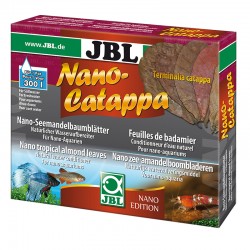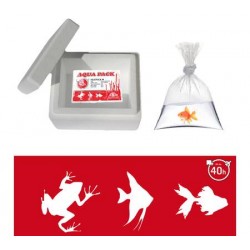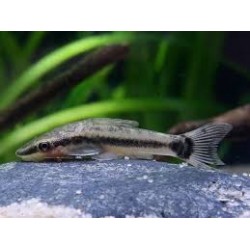Hyphessobrycon Amandae belongs to the family of Characidae or Caracidi.
Like all the Caribbean Tetra nano is a fish greek and he endures loneliness. For this reason it is recommended to set up an aquarium with at least 10 specimens of both sexesi. In this way you will ensure less shy, natural, interesting behavior.
To every order of fish is compulsory buy alsoshipping kit which includes: polystyrene box, warmer (for the winter months) and oxygen. Acquarioshop.it is not responsible for any problems due to delays of the couriers, or due to force majeure, sudden rises or lowerings of the temperature, deaths of the fishes or whatever else is not attributable to L'Arca di Zin Fabio (we cannot know the chemical and physical water values of your aquariums).
It is native to southern America precisely in Brazil where it is present in the hydrographic basin of the river Rio Araguaia.
The most common names with which it is known are: Hemigrammus Amadae, Hyphessobrycon Nano, Amanda, Nana Rossa, Tetra of Fire,Tetra Red Dwarf and Ember Tetra due to its small size. In fact its maximum size does not exceed 2,5 cm. The color varies from intense red to pale orange and some specimens are yellow. The thing that amazes is that these fish live in branches of the same coloration forming well distinct colonies among themselves.
Their beautiful coloring will be more evident in addition to good results of reproduction and longevity. Hyphessobrycon Amandae lives from 3 to 5 years.
Features of Hyphessobrycon Amandae
The aquarium must have minimum dimensions of at least 50x45x45 cm, abound in width because the Tetra nano needs a lot of space for swimming. If possible avoid community aquariums with larger or aggressive fish, they are small and shy then easy prey.
The body has a laterally compressed romboidal shape, coloring becomes very intense. especially in adult males, in the period of reproduction. The males will continually confront each other for the control of the females, but in a very harmless way. This is the reason that helps to accentuate the coloring in brighter tones and from this will be the dominant male that will be of a more intense coloration of all others.
If you look at the backlight you can see a certain transparency, the first rays of the dorsal and anal fins are more pale in color. In the caudal fins the coloring is at the top and bottom. Females are normally more round and round.
It is a very quiet fish but as said it can not compete with larger and noisy tub companions for this reason we recommend an aquarium with peaceful fish, of the same species, of the same size or smaller.
They are recommended as tub companions, Nani Cyclades, Locari, Caracids of similar size, Callittids, Fish Accepts Apistogram.
Bathing equipment
To set up the ideal aquarium start with a tank of at least 60 litres, developed in width. Ember Tetra is native to a biotope from black waters therefore a filtering with peat will give a amber color to the water and will help to maintain the ideal values for the survival of this fish.
The sub layer of preferably dark color, dry branches, trunks, an abundance of dwarf plants on the sides and floating plants in the meadow, leaving free the front and central part for the grating swimming, a litter of leaves in particular will help the formation of microbial colonies as they will decay. A colony of microorganisms can provide a secondary source of food for the breeding of the fir-trees. Moreover the release of tannins and chemicals that will help maintain the right values of the tub, soft and acidic water and will benefit especially the health of our fish.
A good biological or sponge filtration and a delicate movement of water will be sufficient. Avoid illuminating the aquarium too much Tetra nano come from dark waters, so little illuminated and badly tolerate intense and direct lights, indeed you might find yourself with stressed fish, floating plants and long stem are ideal for filtering direct light.
Habitat of Hyphessobrycon Amandae
Originary of Brazil hydrological basin of Rio Araguaia, Rio Das Mortes, Braco Major, Isla do Bananal, Mato Grosso and Rio Tocantins. It lives in small tributaries, ponds and lakes rather than main river channels. All these waters are acidic and soft, typically tropical, often covered by large layers of foliage in decomposition fallen by branches and trees present on the banks.
Lighting and Temperatures
As already mentioned, they do not love intense and direct light, so we must plant the tank abundantly with floating plants or long stem. The temperatures are typically tropical therefore vary from 24° to 28-30°, the PH ranges between 5.0 and 7.0 the water hardness varies between 3° and 10° dGH.
Power supply
Onnivora species accepts all types of dry, frozen, frozen, lyophilized, micro scales, micro granules, live, pellets, as important as they are small in order to adapt them to their mouths, vary the diet daily with prevalence of live, frozen, frozen or otherwise the colors will become less accused and will have difficulty to reproduce. Naupli of Artemia, Moina, Vermi Grindal, Dafnie, Chiromonus are indicated. They are very slow fish to eat, take care to check that they feed. Sometimes it can happen that if the food arrives at the bottom of the tank their interest in that food tends to chew and try to make it reawaken in order to be able to consume it half a tank.
Reproduction of Hyphessobrycon Amandae
H. Amandae is a species Ovipara, of medium reproductive difficulty, which does not care for eggs and fry. In a community aquarium, if the values are ideal you can have a spontaneous reproduction, without any human intervention, and you will notice the reproduction only when the small fry will appear. A limited number surely, since the Ember Tetra feeds on their own eggs, so only the surviving ones will hatch.
They do not form pairs for life but will reproduce with occasional couplings, you will notice the formation of a couple when a more colorful male and a female swollen will begin to swim side by side. First quickly and then slowly, from there to little will happen the actual reproductive act.
Reproduction in Nursery
If you want a good reproduction you have to set up a playback tank or Nursery of at least 10 liters for a couple. Synthetic wool held on the bottom by a network that passes the eggs but does not give way to the parents to predarle, can also go well of the glass scales, the Java musks, Vesicularia dubyana, felce type Microsorum pteropus, scattered on the bottom, as well as floating plants for minimal lighting.
Reproduction takes place mainly at night or at the first hours of the day, then in the shade. We recommend a light peat filtration, a small well-protected filter to avoid the sucking of eggs.
The water must be softer and more sour than the water contained in the large tub, you can use the peat in granules (at first it will tend to float but after it will settle on the bottom) and the leaves of Ketapang dried.
The ideal values are PH between 5-6, water hardness 0, temperature between 27° and 29°. Let the breeding aquarium mature for at least a week after which you insert the pair preferably in late evening, increasing the food of live, frozen and frozen food that stimulates the reproductive instinct and leave it for 2-3 days. If you do not notice eggs within the tank, change the pair of gearbox.
Deposition and hatching of eggs
After the courtship, made of fast chasing and slow pursuits of the two flanked fishes, as mentioned above, the coupling will take place in the shade. The pair will expel eggs and sperm at the same time in several stages. About 50-70 eggs, often among the vegetation.
When the female returns to its normal size, remove both the torque and the protection net from the nursery, inserted inside a small porous stone connected to a small aerator for a good oxygenation, to keep constantly on to avoid the molding of eggs.
The hatching will take place after about 30 hours from the deposition and for at least 3 days the fry will not have to be fed because they will feed of the calve sac. The microfauna inside the tank will help growth but will not be enough, so past this short period you can start feeding them with infusion food such as Rotiferi, Parameci or very small dry feed, about 5-50 microns.
After a week add to the Naupli diet of Artemia and Microworn, often and in small quantities to avoid water pollution.
When the fry seem to you large and strong enough, you can begin to overflow the water of the large bathtub into the nursery. Progressively, in order to adapt the nursery values to those of the tub where you will transfer the fry.
No reviews






















